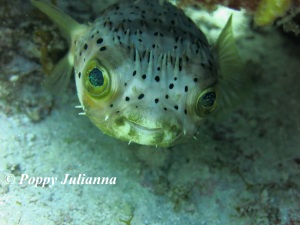Having worked in Grand Cayman as a dive instructor for nine months, there isn’t much I don’t know about the diving there. Whether you’re planning a dive trip to Grand Cayman, considering whether to try diving there or are just curious as to what it is all about, this post is for you.
Grand Cayman is revered as one of the top diving destinations in the world, and it’s not hard to see why. With a drop off to over 4,000ft underwater around the island, it is only a five minute boat ride to access deep dive sites. The reason for this is that the island sits on top of an underwater mountain so it is entirely surrounded by deep water and pelagic marine life.

The marine life inhabiting the waters around the Cayman Islands makes it a dream diving destination for avid divers and novices alike. The ocean ecosystem is so diverse, top to bottom, that it makes every dive such a rush. From as soon as you drop below the surface, right down to the bottom, there is life worth seeing every step of the way regardless of how deep you go.

Depending on the wind and wave conditions you can often find large mats of sargassum weed on the surface. This weed is home to frogfish, nudibranchs, seahorses, crabs, shrimp and many different species of juvenile fish, and was my favourite spot to start and end my dive as I could hang out with the predators underneath. The mid-water column houses a full range of tiny, colourless microorganisms, invisible until they cruise by your mask with the much larger ctenophores (comb jellyfish), tunicates and salps following suit.

The reef ecosystems in Cayman are an excellent example of what a healthy reef should look like and the coral in particular is extremely healthy. From the brain and boulder corals that build the reefs to the gorgonians and sea fans that baffle nutrients down onto the substrate beneath, it everything about the reef seems alive and well. Just the sheer number of different creatures you can see on a single dive never makes for a dull moment. The reefs are covered with parrotfish, grunts and snapper taking shelter amongst the coral below the schools of chromis and wrasse venturing up in the water column above them. Every crag and pore in the reef holds some sort of interesting organism; lobsters, large clinging crabs and eels being the usual suspects.

My favourite part of every dive was the contrast between the reef creatures and the sand habitat surrounding the coral fingers. This is where you would find hogfish, southern stingrays and spotted eagle rays snarfing around in the sand looking for their daily meals amongst the beds of garden eels and rubble piles that house sand tilefish.

My favourite fish are the large, predatory pelagic fish that come up from the water water off the wall and cruise into these areas. The sinewy, silver type that make one close pass to inspect you and are on their way, i.e. the permit, amberjack and african pompano that fly by without giving you the chance to prep your camera.

Found amongst all of this are what Cayman is most famous for: sea turtles! I would say I saw at least one turtle on eighty percent of the dives we did there. If not on the dive then we would definitely see one popping up from the reef on the way in or out.

Hawksbills are the most common sea turtle with loggerheads heading by every now and then in the spring and summer. Green sea turtles are also very common in a few specific areas of the island. As far as the larger marine life goes, we did run into some sharks every now and again which always gave us something to talk about for the next week or so. While nurse sharks are common, the occasional caribbean reef shark or hammerhead could also be seen. Their cousin, the manta ray, was also spotted in a few rare instances. If you want my advice and are able to make the trip, then grab your gear and jump in. You won’t regret it.

























